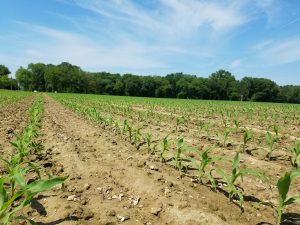Micronutrient deficiencies are commonly exhibited in agronomic crops grown on Delaware’s sandy, low organic matter soils. In 2018, University of Delaware researchers conducted a study at the Carvel Research and Education Center (Georgetown, DE) to examine corn response to manganese (Mn), zinc (Zn), and boron (B) in starter fertilizer. Two rates of Mn (0.25 and 0.5 lb/ac), Zn (0.5 and 1.0 lb/ac), and B (0.15 and 0.30 lb/ac) were applied as a liquid starter with the planter.
Delaware Agronomy Blog
University of Delaware Cooperative Extension
Category: Soil (page 2 of 2)
Amy Shober, Extension Nutrient Management and Environmental Quality Specialist, ashober@udel.edu; Jarrod O. Miller, Extension Agronomist, jarrod@udel.edu; Phillip Sylvester, Kent County Extension Agent, phillip@udel.edu; Cory Whaley, Sussex County Extension Agent, whaley@udel.edu.
Soil temperatures need to stay above 50°F and we need to accumulate 100 to 125 growing degree days (GDD) in order for corn to germinate and emerge. From April 22 to May 1, soil temperatures have consistently stayed above 50°F from Georgetown to Newark, and most parts of the state have gotten some rainfall to keep the soil surface moist . Sussex County is a little bit ahead of Kent and New Castle Counties in terms of GDD (68 in Georgetown vs. 61 and 47 in Dover and Newark, respectively since April 22). A new online tool developed by Cornell University allows you to estimate growing degree days from planting for your own fields: http://climatesmartfarming.org/tools/csf-growing-degree-day-calculator/ With the end of this week temperatures topping out in the upper 80s, some of your fields that were planted last week may start to emerge.
Freezing Temperatures and Topsoil Compaction
Last weeks polar vortex stuck around long enough to cause a pretty significant freeze on our soil surfaces. With our temperatures swinging from 0 to 60°F, we have certainly had the conditions for freeze/thaw in our soils, which is considered a physical weathering process. Continue reading
© 2025 Delaware Agronomy Blog
Theme by Anders Noren — Up ↑


